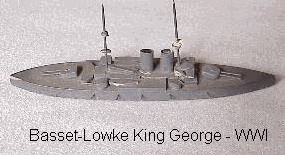 The British Navy made use of the miniature ship models in the
years prior to World War I. Ronald Fuller, author of "The Bassett-Lowke Story",
writes, "It was, however, the hand-made series that interested ship lovers, and over
the years until 1939 when production for retail sale was discontinued, models of every new
ship of importance were produced and avidly collected by enthusiasts. It was also this
class of model that interested the Admiralty as they realized that their three-dimensional
depiction was much more useful for recognition training than the customary silhouette
drawing. From 1911 on there were regular contracts from the Admiralty, and, in the Second
World War, also from the R.A.F. During both World Wars, of course, enormous quantities
were produced for personnel training. The fact that they were hand-made enabled any
reconstruction of the prototype to be rapidly reproduced."
The British Navy made use of the miniature ship models in the
years prior to World War I. Ronald Fuller, author of "The Bassett-Lowke Story",
writes, "It was, however, the hand-made series that interested ship lovers, and over
the years until 1939 when production for retail sale was discontinued, models of every new
ship of importance were produced and avidly collected by enthusiasts. It was also this
class of model that interested the Admiralty as they realized that their three-dimensional
depiction was much more useful for recognition training than the customary silhouette
drawing. From 1911 on there were regular contracts from the Admiralty, and, in the Second
World War, also from the R.A.F. During both World Wars, of course, enormous quantities
were produced for personnel training. The fact that they were hand-made enabled any
reconstruction of the prototype to be rapidly reproduced."
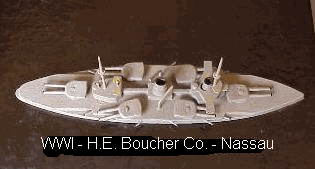 The United States
Navy also found the models useful for wargaming and as an aid in teaching ship
identification. These models were produced by The H.E.
Boucher Manufacturing Company of New York. Beginning in 1905 and
continuing through the mid 1920’s Mr. Boucher conducted the Experimental and Model
Shop in Washington. This facility produced models for the U.S. Navy Department, U.S. War
Department, U.S. Shipping Board, the National Museum and various foreign governments and
private companies. The identification models were produced for the U.S.
The United States
Navy also found the models useful for wargaming and as an aid in teaching ship
identification. These models were produced by The H.E.
Boucher Manufacturing Company of New York. Beginning in 1905 and
continuing through the mid 1920’s Mr. Boucher conducted the Experimental and Model
Shop in Washington. This facility produced models for the U.S. Navy Department, U.S. War
Department, U.S. Shipping Board, the National Museum and various foreign governments and
private companies. The identification models were produced for the U.S. 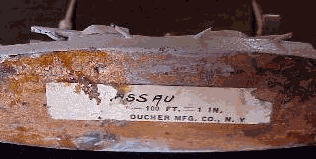 Navy Bureau of Odrance in a scale of 1: 1200. The Oregon
Historical Society Museum has a set representing eighteen different German ships from the
pre-WWI period. This set is marked "No. 87", however, the number of sets
produced and how they were distributed and used is not known. These models have wood hulls
and look similar to the early Bassett Lowke models. The are made with cast turrets instead
of the wood & wire turrets found on the Bassett Lowke models. The turrets on models by
both manufacturers are fastened to the hull with pins that allow then to rotate. The
Boucher models are identified by a paper tag glued to the bottom of the hull that
identifies the model No. and name, the scale as 100 ft = 1 in, and the manufacturer as the
H.E. Boucher Mfg. Mfg Co., N.Y. In the
United States Boucher continued producing ship models and kits. While there is no evidence
that they produced any more ship identification models for the navy, Fletcher Pratt’s
book on Naval War Games (circa 1940) mentions that F.A.O. Schwarz, a New York toy store,
sold Boucher models in a scale suitable for wargaming.
Navy Bureau of Odrance in a scale of 1: 1200. The Oregon
Historical Society Museum has a set representing eighteen different German ships from the
pre-WWI period. This set is marked "No. 87", however, the number of sets
produced and how they were distributed and used is not known. These models have wood hulls
and look similar to the early Bassett Lowke models. The are made with cast turrets instead
of the wood & wire turrets found on the Bassett Lowke models. The turrets on models by
both manufacturers are fastened to the hull with pins that allow then to rotate. The
Boucher models are identified by a paper tag glued to the bottom of the hull that
identifies the model No. and name, the scale as 100 ft = 1 in, and the manufacturer as the
H.E. Boucher Mfg. Mfg Co., N.Y. In the
United States Boucher continued producing ship models and kits. While there is no evidence
that they produced any more ship identification models for the navy, Fletcher Pratt’s
book on Naval War Games (circa 1940) mentions that F.A.O. Schwarz, a New York toy store,
sold Boucher models in a scale suitable for wargaming.
The naval buildup in the 1930’s resulted in increased intelligence activities with the aim of knowing what your friends and your potential enemies were building. Jane’s Fighting Ships has long been acknowledge as one of the foremost authorities on the world’s naval forces, however, some of the information found in Jane’s during this time proved to be more propaganda than fact due to the secrecy imposed by the various navies and their shipyards. A comparison of some of the early identification models with the data in Jane’s shows that the models were based on drawings and data which later proved to be in error. Mr. Derek Head, in his book "Bassett-Lowke Waterline Ship Models" writes: "All the warship models produced in the 1920s and 1930s for sale to the general public were constructed from information available in the well-known publication Jane's Fighting Ships - an annual which listed and illustrated, by photograph and plan, most of the major ships in the world's navies. However, whether intentionally or otherwise, the drawings of British warships were frequently inaccurate in hull form, profile and superstructure detail. As a result the models were also incorrect.".
At the beginning of the 1940’s it again became apparent that ship identification models would be a necessary aid to supplement the identification manuals then in use. These pocket-size "Basic Field Manual’s", produced by the War Department, were essentially picture and plan books that covered the ships of the various naval powers. Some of the pictures in the manuals are of models that were specifically produced for the purpose. The Office of Naval Intelligence published an extensive series of identification manuals during the war years and pictures of models continued to be used for target angle pictures and identification. These models were initially built at the David Taylor Model Basin in Carderock, Maryland, and in 1941 by a Mr. Van Riper, a professional model builder in Vineyard Haven, Massachusetts. An article in the January 1944 issue of Popular Mechanics shows women at the David Taylor facility making 1:500 scale ship models.
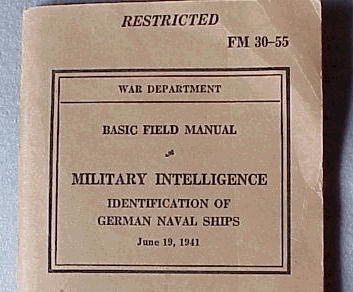
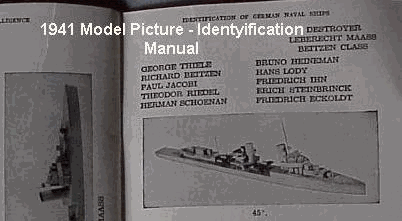
WWII Ship Model Manufacturers in the United
States
During World War II the U.S. Navy contracted with four manufacturers to produce ship
identification models at a scale of 1:1200 for use by the various armed forces and the
merchant marine. The earliest manufacturer was a small company with 4 - 8 employees
located in the Bronx area of New York city. It was known as the Bessarabis
Company, being named after its founder who is reported to have emigrated
from Finland in 1939/40. Bessarabis produced an unknown number of sets, probably less than
1,000, before their contract was terminated. The models found in the sets were also issued
individually and some boxes may have Army Air Force Stock Numbers written on them. These
models were produced during the period between approximately 1940 & 1942. There are no
markings on the models to indicate a date of manufacture but a review of identification
manuals and other material shows that all of the ships that the models represent were in
service or under construction prior to the end of 1942. The models were most likely
manufactured in 1941 or 2 prior to the 1/43 date found on some models in sets manufactured
by Comet Metal Products Co., Inc., of Richmond Hill, N.Y.. Bessarabis produced the only
submarine models issued during the war with one exception. One of the first sets produced
by Comet contains the only submarine model found in any of their wartime sets. This set
contains eight models of U.S. Navy ships and includes a model of the USS Sargo, an early
"S" class boat.
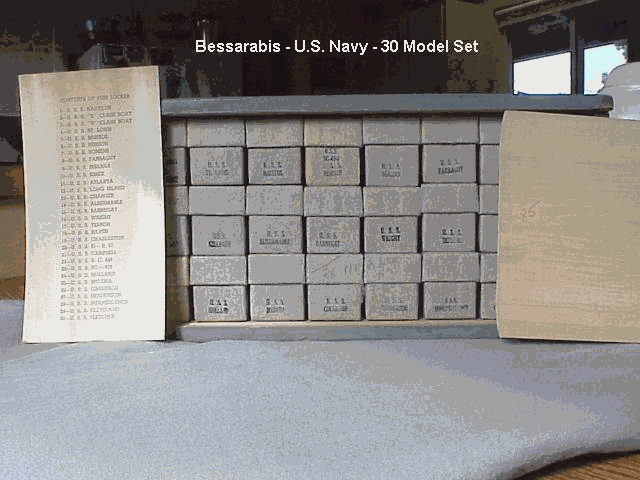 Bessarabis produced two sets of United States Navy ship models,
each consisting of 30 models.These models are not attached to mounting boards but are
wrapped in soft paper and inserted into 27 individual cardboard boxes. Three of the boxes
each containing two models and all boxes are stamped with the name of the model or models
it contains. The models for each set are carried in a wooden case closed with a sliding
top. On the inside of the sliding top is a set number handwritten in red pencil. Each case
contains a "Contents of this Locker" card that lists the numbers and names of
the models. The only identifying mark on the models is a raised number on the bottom of
the hull that is sometime found in an oval depression. Models in both sets are numbered
from 1 through 30 resulting in two models of different ships having the same number.
Identifying characteristics of the models are found in the gun barrels that have a
tendency to be flat on the bottom and in the masts which are cast, not wire as found on
the models produced by other manufacturers.
Bessarabis produced two sets of United States Navy ship models,
each consisting of 30 models.These models are not attached to mounting boards but are
wrapped in soft paper and inserted into 27 individual cardboard boxes. Three of the boxes
each containing two models and all boxes are stamped with the name of the model or models
it contains. The models for each set are carried in a wooden case closed with a sliding
top. On the inside of the sliding top is a set number handwritten in red pencil. Each case
contains a "Contents of this Locker" card that lists the numbers and names of
the models. The only identifying mark on the models is a raised number on the bottom of
the hull that is sometime found in an oval depression. Models in both sets are numbered
from 1 through 30 resulting in two models of different ships having the same number.
Identifying characteristics of the models are found in the gun barrels that have a
tendency to be flat on the bottom and in the masts which are cast, not wire as found on
the models produced by other manufacturers.
Bessarabis also produced one set of 29 models of German Navy ships. These models are also found in individual cardboard boxes stamped with the name of the ship it contains. The boxes are carried as a set in a wooden case holding 30 boxes of two different sizes, 18 "standard' size and 12 smaller ones, one being an empty filler box. The only identifying mark on the models is a number with a prefix "G" cast into the bottom of the hull. The outside of the sliding top of the case is stamped "German Ships". The inside of the top has a set number handwritten in green pencil.
Comet Metal Products Company produced the majority of the models used by the services during WWII. The company was founded by the Slonim brothers who had emigrated from Germany to England, via Sweden, about 1938. While in England it is reported that they work for TreMo, a manufacturer of small scale ship models, before emigrating to the United States and establishing Comet Metal Products company.
Comet apparently produced individual models for the services as early as 1/42, a model of the Curtiss (AV) carries this date, these early models are painted a lighter gray than models found in the later sets. Army Air Force stock numbers found on individual model boxes indicate that these models were also issued individually. The earliest models produced by Comet are undated, they are identified by an ink stamped name on the bottom of the hull instead of the later cast identification on the side, some have COMET cast in raised letters on the bottom of the hull. Some of these models appear to be copies of Wiking models from the late 1930's.
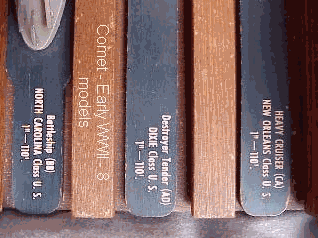
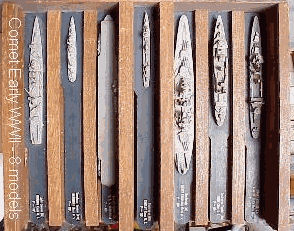
Comet's first set of models contains only eight models of US Navy ships. These models are carried in a small wooden case with their mounting sticks sliding into grooves cut into the pieces separating the models. The case is stained instead of being painted and is of a different type than any of the other sets. The bottom of the case is stamped with "Case & mountings created by KAY DISPLAYS, INC.", along with their address in Grand Rapids, Michigan. Some cases may also have a stamped U.S. Navy anchor. The dark blue mounting sticks are marked with the type and class name and a scale of 1" = 110’. The models are actually built closer to a scale of 1:1250; some may be dated 1/43 which would indicate an update of earlier undated models, these scale close to 1:1200 scale.
Comet and South Salem companies jointly produced models for a set containing 47 U.S. Navy ships models. Comet manufactured 30 of the models and South Salem manufactured the remaining 17. All of the models are identified with a name or class name and type cast into the starboard side of the hull, with one exception, the model of the Yorktown class has the identification cast into the port side. The Comet models are all marked 1/43 on the bottom of the hull except for the Bogue class which is marked 2/43. The South Salem models have no bottom of hull markings. All of the plywood mounting boards for the Comet models are stamped with the ship name and "Mfg. By Comet Metal Products Co., Inc., Richmond Hill, N.Y.". The mounting boards for the South Salem models are printed with the ship class name & type and "South Salem Studios, South Salem, N.Y".
South Salem Studios was a small shop owned by Mr. Enzo Yocca who emigrated from France prior to WWI. He specialized in miniatures and with the outbreak of WWII offered the services of his shop to the Navy. South Salem also received another contract to produce a set of 16 models of merchant ships that are dated 2/45. They continued producing models under these contracts throughout the war but for reasons as yet unclear they received no further contracts for 1:1200 scale models. They also produced a set of "Auxiliary Pocket Models" of merchant & warships in 1:2000 & 1:5000 scale.
Beginning in late 1942 Comet received additional contracts to produce a set of 15 German Navy ships models, two sets totaling 28 Japanese Navy ship models and one set of 25 Japanese Marus (merchant ship models). In late 1945 or early 1946 Comet bought out South Salem and may have continued selling models under that name. The Comet Japanese Marus are not the same models as the South Salem merchant ships. The Merchant Ships of All Nations, sold by Comet at the end of the war, are renamed Japanese Maru models. Comet continued to produce models for sale to the public well into the post war years and greatly expanded the number of models offered.
In mid-1942 the H.A. Framburg & Co., of Chicago received a contract to manufacture a set of 29 models of British Navy ships. This contract was followed by one in 1944 to produce a set with 16 additional models, 12 of British ships and 4 of French ships. Framburg's final contract was to produced a set with 14 models of U.S. Navy ships. Framburg ceased production at the end of the war and sold their surplus stock to the public.
These companies also produced sets of models at a scale of 1:500, commonly called "Teacher Scale", which contained models representative of most warship classes. They contained about half the number of models found in the 1:1200 scale sets.
